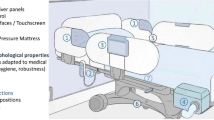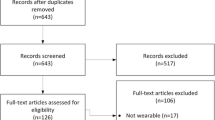Abstract
This article has presented a conceptual framework for the effect evaluation of the intelligent bed. The overall study is inspired by the case study design. Different functions with wireless sensor technology have been tested in Denmark and China. We have included technical aspects concerning on how different hardware have been operated in the different contexts, and how these applications and standards affect the process of performing clinical tasks. We have also discussed how the cultural differences and barriers can be highlighted by the evaluation system in the test of the intelligent bed. We concluded that it is important to realize the difference on the local social–cultural, economic context as well as the technical infrastructures. A process perspective should bear in mind when adopting new technology. It is also important to involve all the stakeholders including patients, healthcare professionals and researchers, etc., as a good way to facilitate the process of accepting of the technology.





Similar content being viewed by others
References
Kidholm, K., Ekeland, A. G., Jensen, L. K., Rasmussen, J., Pedersen, C. D., Bowes, A., et al. (2012). A model for assessment of telemedicine applications: Mast. International Journal of Technology Assessment in Health Care, 28(1), 44–51. doi:10.1017/S0266462311000638.
Bygholm, A., & Kanstrup, A. M. (2014). Learning from an Ambient Assisted Living Lab: The case of the intelligent bed. Studies in Health Technology and Informatics, 205, 318–322.
Kanstrup, A. M., & Bertelsen, P. (2011). User innovation management, a handbook. Aalborg: Aalborg University Press.
Saliba, V., Legido-Quigley, H., Hallik, R., Aaviksoo, A., Car, J., & McKee, M. (2012). Telemedicine across borders: A systematic review of factors that hinder or support implementation. International Journal of Medical Informatics, 81(12), 793–809. doi:10.1016/j.ijmedinf.2012.08.003.
Wootton, R. (2012). Twenty years of telemedicine in chronic disease management-an evidence synthesis. Journal of Telemedicine and Telecare, 18(4), 211–220. doi:10.1258/jtt.2012.120219.
World Health Organization. (2012). Home Care Across Europe, current structure and future challenges.
Yin, R. K. (2008). Case study research design and methods. London: SAGE.
Stake, R. E. (1995). The art of case study research. London: SAGE.
Rubin, H. J., & Rubin, I. S. (2011). Qualitative interviewing: The art of hearing data. London: SAGE.
Israel, A., Eng, E., Schulz, A. J., & Parker, E. A. (2012). Methods for community-based participatory research for health. San Francisco: Jossey-Bass.
Prior, L. (2003). Using documents in social research. London: SAGE.
Davis, F. D. (1989). Perceived usefulness, perceived ease of use, and user acceptance of information technology. MIS Quarterly, 13(3), 319. doi:10.2307/249008.
Tidd, J., & Bessant, (2009). Managing innovation: Integrating technological, market and organizational change. London: Wiley.
Kuada, J. E. (2003). Culture and technological transformation in the South: Transfer or local innovation. Copenhagen: Samfundslitteratur.
Ketikidis, P., Dimitrovski, T., Lazuras, L., & Bath, P. A. (2012). Acceptance of health information technology in health professionals: An application of the revised technology acceptance model. Health Informatics Journal, 18(2), 124–134. doi:10.1177/1460458211435425.
Holden, R. J., & Karsh, B. T. (2010). The technology acceptance model: its past and its future in health care. Journal of Biomedical Informatics, 43(1), 159–172. doi:10.1016/j.jbi.2009.07.002.
Gagnon, M. P., Orruno, E., Asua, J., Abdeljelil, A. B., & Emparanza, J. (2012). Using a modified technology acceptance model to evaluate healthcare professionals’ adoption of a new telemonitoring system. Telemedicine and e-Health, 18(1), 54–59. doi:10.1089/tmj.2011.0066.
Sherer, S. A. (2010). Information systems and healthcare XXXIII: An institutional theory perspective on physician adoption of electronic health records. Communications of the Association for Information Systems, 26(7), 127.
Rogers, E. M. (2003). Diffusion of innovations. New York: Free Press.
Evans, H. H. (1993). High tech vs ‘high touch’: The impact of medical technology on patient care. In J. M. Clair, R. M. Allman (Eds.), Sociomedical perspectives on patient care (pp. 82–95). Lexington: The University Press of Kentucky.
Valero, M. A., Arredondo, M. T., Guillen, S., Traver, V., Fernandez, C., Basagoiti, I., et al. (2001). Impact of a broadband interactive televisit/teleconsultation service for residential and working environments. Proceedings of the AMIA Symposium, 721–725.
Kuszler, P. C. (1999). Telemedicine and integrated health care delivery: Compounding malpractice liability. American Journal of Law and Medicine, 25, 297–326.
Brigden, M., Minty, A., Pilatzke, S., Della, Vidov, L., Sherrington, L., et al. (2008). A survey of recipient client physician satisfaction with teleoncology services originating from thunder bay regional health sciences centre. Telemedicine and e-Health, 14(3), 250–254.
Kvale, S., & Brinkmann, S. (2008). Interviews: learning the craft of qualitative research interviewing (2nd ed.). Los Angeles: SAGE Publications Ltd.
Conflict of interest
No conflicted interests are existed in the research.
Author information
Authors and Affiliations
Corresponding author
Rights and permissions
About this article
Cite this article
Cai, H., Toft, E. & Dinesen, B. A Conceptual Framework for the Effect Evaluation of the Intelligent Bed. Wireless Pers Commun 80, 1405–1414 (2015). https://doi.org/10.1007/s11277-014-2090-7
Published:
Issue Date:
DOI: https://doi.org/10.1007/s11277-014-2090-7




